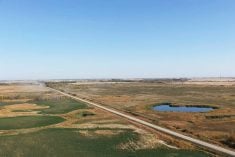Two costly mistakes irrigation farmers can make are not starting to irrigate soon enough in spring and not applying enough water to keep up with crop water demands during the growing season. Good irrigation water management simply involves determining the correct amount of irrigation water to apply at the right times.
The goal of irrigation scheduling is to ensure a crop is never under water-induced stress, which can limit yield potential. Eight key factors to be mindful of include the following:
1. Know the soil textures of your fields to determine the soil water holding capacity and amount of plant-available water for each soil type in each field (see my March 21 Grainews column “How to understand and measure soil water” to review definitions).
2. Know the allowable depletion point of soil moisture that can be removed from each soil type before irrigation is required. The allowable depletion point varies with different soil types and different crops.
3. Learn how to check the soil moisture content of your fields.
4. Check soil moisture weekly in each field throughout the season and twice weekly during peak water use.
5. Know daily water use for each crop at each growth stage.
6. Be aware of how daily crop water use varies with changing environmental conditions.
7. Know the effective rooting depth of your various crops at each growth stage.
8. Know your irrigation system gross and net water output to apply correct amounts of irrigation water.
Read Also

Claas brings 1000 Series SP forage harvesters to Canada
In mid-August, Claas unveiled its new line of Jaguar forage harvesters at an event in Visalia, California, deep in the heart of that state’s dairy region.
The amount of water a soil can retain depends on the texture of the soil. I discussed this in the March 21 Grainews issue mentioned above. The amount of plant-available water varies by soil texture (see Table 1 in the March 21 issue). These values should be used to estimate plant-available water.
Soil water
The terms field capacity, permanent wilting point and plant-available water have been explained fully in the March 21 issue. However, to review briefly, field capacity is the amount of moisture remaining in the soil several days after a saturating rain or irrigation, after gravity has caused free water in larger soil pores to move downward through the soil profile and below the plant root zone.
Permanent wilting point occurs when plants have extracted all plant-available water to a level that causes plants to wilt and die. The soil water between field capacity and permanent wilting point is called plant-available water, which is the amount of water plants can utilize.
For most crops, about 40 per cent of the plant-available water in soil can be extracted without incurring any water-limiting stress that would affect crop yield or quality. After about 50 per cent of the plant-available water is used, the remaining available water gradually becomes increasingly difficult for plants to extract and take up.
For irrigation farmers, two critical terms to understand are allowable depletion and readily available water. Allowable depletion is the amount of water that can be removed from soil without affecting crop yield or inducing crop water stress. The water between field capacity and allowable depletion is referred to as readily available water.
The allowable depletion for most cereal and oilseed crops is about 40 per cent. This means when about 40 per cent of the available water is used, irrigating the soil to near field capacity is necessary. Allowable depletion is usually determined and expressed in millimetres per depth of soil. Allowable depletion can vary with soil type, crop type, stage of crop growth and effective rooting depth of the crop.
Effective crop rooting depth
The effective rooting depth of a crop occurs where most of the plant roots are concentrated and extract water for uptake. For example, for cereal crops, rooting depth gradually increases during the vegetative growth stages, but by the start of anthesis, downward root growth has ceased.
The effective rooting zone is the soil depth where roots take up most of their water. For a typical irrigated wheat crop at anthesis or canola crop at flowering, the effective root zone is usually about 100 centimetres (40 inches).
Roots can extend downward to 120 cm or more, but most of the effective roots are within the top 100 cm. Typically, roots are more concentrated in the upper half of the root zone. As a result, a cereal crop usually extracts most of the water from the upper half of the effective root zone (top 50 cm) where there is a greater abundance of roots and water is easily accessed. Also, in the upper half of the root zone, soil temperature is often a bit warmer, soil organic matter levels are greater, soil biological activity is greater, plant-available nutrient levels are higher and soil aeration is more favourable. All of which provide desirable conditions for more abundant root growth and development.
Typically, about 40 per cent of water uptake is from the 0–25 cm depth of the root zone and about 30 per cent of water uptake comes from the 25–50 cm depth of the root zone for a total of 70 per cent of the water requirements. In the 50–75 cm depth, about 20 per cent of water is taken up and in the 75–100 cm depth only about 10 per cent is taken up for a total of 30 per cent of wheat water requirements from the lower half of the effective root zone.
With about 70 per cent of water requirements taken up from the upper half of the effective root zone, a very good irrigation management practice for irrigation farmers is to ensure soil water is maintained between field capacity and allowable depletion in the upper half of the effective root zone throughout the growing season to prevent crop water stress.
An effective irrigation management strategy for most cereal and oilseed crops is to build up soil moisture to near field capacity in the full 100 cm root zone in the spring and maintain soil moisture in the top 50 cm between field capacity and 60 per cent of plant-available water (allowable depletion point) throughout the growing season.
Crop water use and evapotranspiration
The approximate daily water used by crops varies by growth stage over the growing season. Daily water use can be variable depending on environmental conditions such as temperature, humidity, solar radiation, soil moisture level and wind. For example, daily water use by wheat at peak use is usually about seven millimetres per day but can be up to 10 mm per day when weather is very hot and windy and soil water is abundant.
For irrigation farmers in southern Alberta, daily crop water use data can be accessed for many locations at agriculture.alberta.ca/acis/imcin/irricast.jsp. Farmers can select the weather station nearest to their farms and then enter their crop information to determine estimated daily water use for their crops based on local weather information.
Pivot irrigation
Pivot irrigation is used on about 88 per cent of all irrigated land in Alberta. Low pressure pivots with drop tubes and spray nozzles have become the most dominant form of irrigation due to ease of operation and water application and energy efficiencies.
To accurately manage pivot irrigation, it is important to know how much water your pivot is applying. Also, recognize that pivots are not 100 per cent efficient in applying water. Gross irrigation water application is the amount of water put out by the irrigation system. Net irrigation water application is the amount of water that is stored in the soil after irrigation. The net divided by the gross irrigation water application is called the irrigation application efficiency.
Generally, a low pressure pivot with drop tubes applies water at 80 to 85 per cent efficiency and a high pressure pivot with impact nozzles is about 75 per cent efficient. These percentages can vary significantly depending on wind speed, air temperature and other factors such as pivot operating speed.
When an irrigation system applies water, a portion is lost through evaporation of spray water before reaching the soil, water evaporation from the soil surface and crop canopy and by surface runoff when the water application rate exceeds the infiltration rate of the soil. Efficiency is also affected depending on the time of day when water is applied.
Water application efficiency in hot windy weather at mid-day is lower than the application efficiency when air is calm and cool during nighttime conditions.

Table 1 (above) shows the gross water application in mm for a 54-hectare (133-acre) quarter section pivot with an output ranging from 700 to 1200 U.S. gallons per minute when completing a full circle in 24, 48, 72 and 96 hours (1, 2, 3 and 4 days, respectively).
Table 2 (below) shows the net water application in mm for a pivot with the same conditions, assuming a water application efficiency of 85 per cent. Note that using 85 per cent efficiency is a simplistic approach as evaporation losses vary with pivot speed and the time of day of application.

Other factors, in addition to weather factors, may include condition of the nozzles and overall maintenance of the pivot. Information in Tables 1 and 2 are provided in U.S. gallons per minute because most pivot irrigation equipment — and, therefore, pivot, nozzle and pump specifications — used in Western Canada comes from the United States.
Important information for pivot irrigation managers is the gross and net water output of each pivot irrigation system on the farm. If net water application is overestimated, it will cause underapplication of irrigation water over the irrigation season, which could lead to reduced crop growth and yield.
In my next column, I will provide details on pivot irrigation systems management.
















